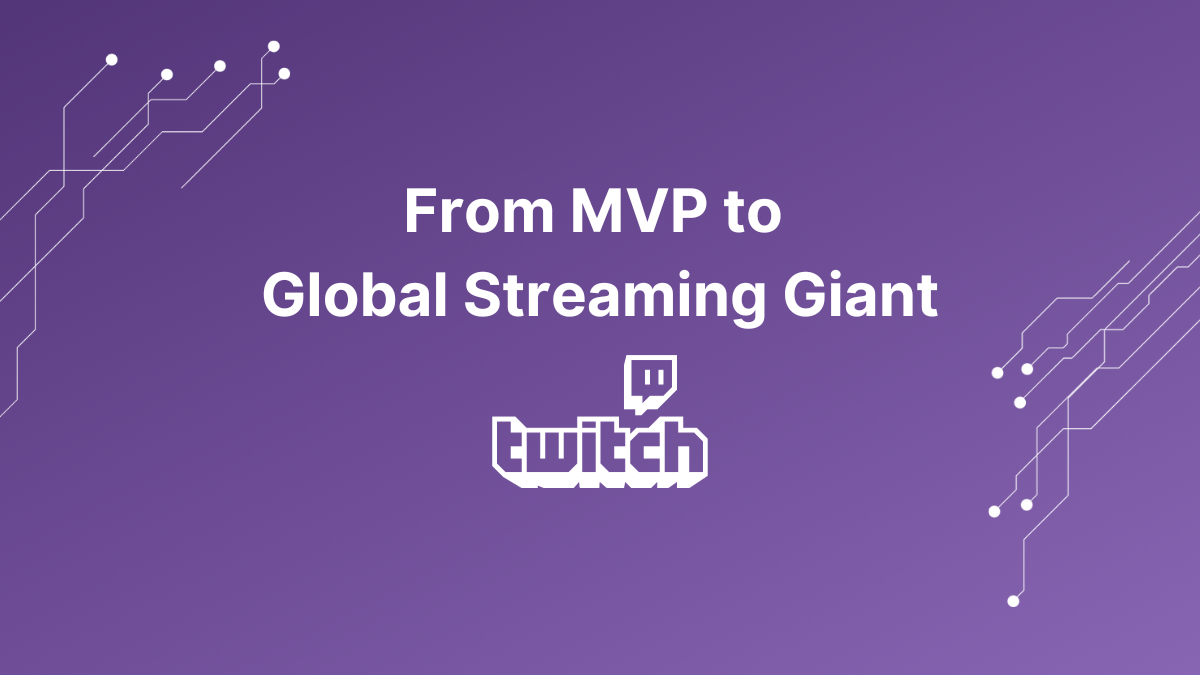From MVP to Global Streaming Giant

In the ever-evolving world of online streaming, Twitch has emerged as the undisputed leader, providing a platform for millions of gamers, creators, and enthusiasts to broadcast and share their content. However, Twitch's journey from a simple Minimum Viable Product (MVP) to its current status as a global streaming powerhouse was a process filled with innovation, adaptation, and community building.
In this article, we'll explore the MVP stages of Twitch, tracing its origins, early development, and the strategies that led to its unprecedented growth.
Genesis: Justin.tv and the Birth of Twitch (2007-2011)
Twitch's story begins with Justin.tv, a platform founded by Justin Kan and Emmett Shear in 2007. The concept behind Justin.tv was straightforward: a live-streaming platform that allowed anyone to broadcast their lives in real-time. The MVP was simple, yet ground-breaking at the time, consisting of a single camera strapped to Justin Kan's head, broadcasting his everyday experiences.
However, the MVP revealed an unexpected trend – gaming content attracted a significant and dedicated audience. Gamers began using the platform to share their gameplay, engage with viewers, and build communities around their favourite titles. Recognising this opportunity, Justin.tv rebranded and relaunched as Twitch.tv in June 2011, focusing exclusively on gaming content.
Early Stages: Nurturing the Gaming Community (2011-2014)
Twitch's pivot to gaming marked the beginning of a new era. The platform was designed with gamers in mind, offering features like live chat, donations, and subscriber badges that encouraged viewer engagement. This MVP stage was characterised by a laser-focused approach to fostering a thriving gaming community.
Twitch introduced the concept of "Twitch Partners" in 2011, allowing popular streamers to monetise their content through ads, subscriptions, and virtual goods. This not only incentivised content creators to stay on the platform but also attracted a growing number of professional gamers and eSports organisations. The Twitch ecosystem was evolving, and the platform was steadily scaling.
Scaling and Innovation: Expanding Horizons (2014-2017)
The years 2014 to 2017 marked a period of rapid expansion and innovation for Twitch. During this MVP stage, Twitch transcended its gaming niche, embracing creative content, music, and even real-life "IRL" streams. This diversification was accompanied by infrastructure upgrades, improved video quality, and expanded partnerships with game developers.
One of the pivotal moments during this period was Amazon's acquisition of Twitch for nearly $1 billion in 2014. This investment injected resources into the platform, allowing it to scale rapidly. Amazon Web Services (AWS) played a significant role in ensuring a stable streaming experience for millions of users worldwide.
The Twitch Ecosystem Today (2017-Present)
In recent years, Twitch has solidified its position as the dominant live-streaming platform. The MVP stages of Twitch, from its humble beginnings as Justin.tv to its evolution as a global streaming giant, have been marked by continuous innovation and adaptation to user needs.
Today, Twitch boasts millions of content creators, millions of daily viewers, and a thriving economy driven by subscriptions, donations, and sponsorships. The platform has become a cultural phenomenon, with events like TwitchCon, collaborations with major brands, and the rise of "Twitch celebrities."
Key Takeaways from Twitch’s Story
1. Identify Niche Markets: The advantage lies in conducting thorough market research to pinpoint underserved or emerging niches where a new MVP could thrive.
2. Focusing on Community Building: Twitch's focus on community meant that users felt comfortable providing feedback and suggestions for improvement. This constant feedback loop allowed Twitch to iterate on its MVP rapidly, addressing user concerns and making necessary improvements. This responsiveness to the community's needs was a key factor in Twitch's growth.
3. Diversification and Adaptation: Remain open to diversification and adaptation, similar to Twitch's expansion into various content categories. This may mean building flexible MVPs that can evolve to accommodate changing market trends or user preferences.
4. Quality and Innovation: Quality and innovation are critical aspects of MVP development, as seen in Twitch's continuous improvements in streaming technology. Emphasise the importance of staying at the forefront of technological advancements.
Conclusion
The MVP stages of Twitch provide a remarkable case study of the evolution of a digital platform. What began as a simple live-streaming experiment transformed into a global powerhouse, redefining how we consume and engage with content. Twitch's success can be attributed to its unwavering focus on community, innovation, and adaptability. As it continues to evolve, one can only anticipate the exciting developments that lie ahead for this streaming giant.
It's Your Turn Now!
Inspired by Twitch’s story? It’s your turn now. Let’s bring your ideas to life. DoganTech's specialists are available to assist you in crafting your MVP, ensuring you embark on a promising journey. Schedule a call with us to kickstart your business with a strong MVP foundation. Don’t forget to visit our blog and follow our social media accounts for more inspiring stories!
As a Software Development Agency, DoganTech offers an exceptional all-in-one software development project package. This is one of our most popular packages, through which our clients benefit from our range of high-quality services in a single customised package.
Our offer is carefully designed for Startups ready to initiate, grow and transform their businesses.
If you are ready to take your Startup to the next level, read on and learn more about DoganTech’s Software Development Project Package!
Have a great idea for your new Startup, but need an extra hand to build a working product to validate it?
Let’s work on your product, run your project and develop your MVP (Minimum Viable Product) together. Get answers to all your questions about technology and product & project management from our team, who are experts in working with Startups and delivering the best value.
High quality, secure and rapidly-delivered software development services. Our services include but are not limited to: MVPs, software products and front-end & back-end software development.
Related Posts

Understanding the MVP Development Process: A Step-by-Step Guide

Minimum Viable Product – Benefits and Tips

5 Common Misconceptions About MVP Development for Non-Technical Cofounders
